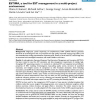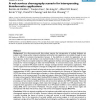BMCBI
2004
13 years 11 months ago
2004
Background: The increasing number of protein sequences and 3D structure obtained from genomic initiatives is leading many of us to focus on proteomics, and to dedicate our experim...
BMCBI
2004
13 years 11 months ago
2004
Background: Information obtained by DNA microarray technology gives a rough snapshot of the transcriptome state, i.e., the expression level of all the genes expressed in a cell po...
BMCBI
2004
13 years 11 months ago
2004
Background: A wealth of quality genomic and mRNA/EST sequences in recent years has provided the data required for large-scale genome-wide analysis of alternative splicing. We have...
BMCBI
2004
13 years 11 months ago
2004
Background: Single-pass, partial sequencing of complementary DNA (cDNA) libraries generates thousands of chromatograms that are processed into high quality expressed sequence tags...
BMCBI
2004
13 years 11 months ago
2004
Background: Computational gene prediction continues to be an important problem, especially for genomes with little experimental data. Results: I introduce the SNAP gene finder whi...
BMCBI
2004
13 years 11 months ago
2004
Background: To cancel experimental variations, microarray data must be normalized prior to analysis. Where an appropriate model for statistical data distribution is available, a p...
BMCBI
2004
13 years 11 months ago
2004
Background: Very often genome-wide data analysis requires the interoperation of multiple databases and analytic tools. A large number of genome databases and bioinformatics applic...
BMCBI
2004
13 years 11 months ago
2004
BMCBI
2004
13 years 11 months ago
2004
Background: Despite the passing of more than a year since the first outbreak of Severe Acute Respiratory Syndrome (SARS), efficient counter-measures are still few and many believe...
BMCBI
2004
13 years 11 months ago
2004
Background: Increasingly researchers are turning to the use of haplotype analysis as a tool in population studies, the investigation of linkage disequilibrium, and candidate gene ...




